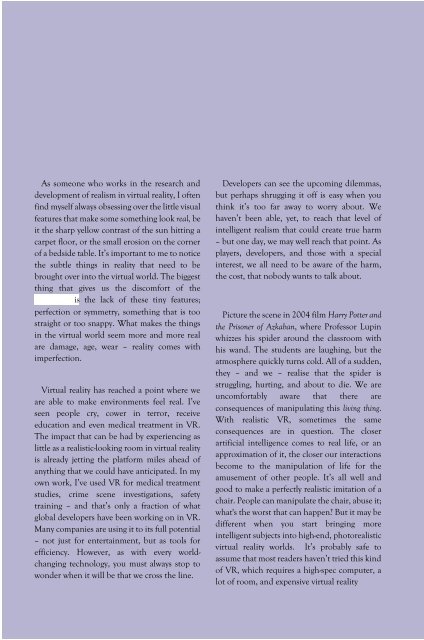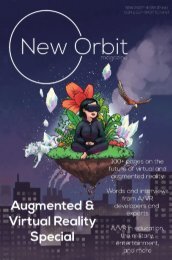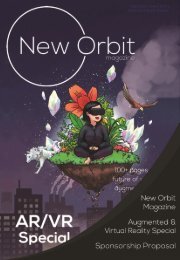Feb 2018 v01 online
((Incomplete formatting))
((Incomplete formatting))
Create successful ePaper yourself
Turn your PDF publications into a flip-book with our unique Google optimized e-Paper software.
As someone who works in the research and<br />
development of realism in virtual reality, I often<br />
find myself always obsessing over the little visual<br />
features that make some something look real, be<br />
it the sharp yellow contrast of the sun hitting a<br />
carpet floor, or the small erosion on the corner<br />
of a bedside table. It’s important to me to notice<br />
the subtle things in reality that need to be<br />
brought over into the virtual world. The biggest<br />
thing that gives us the discomfort of the<br />
is the lack of these tiny features;<br />
perfection or symmetry, something that is too<br />
straight or too snappy. What makes the things<br />
in the virtual world seem more and more real<br />
are damage, age, wear – reality comes with<br />
imperfection.<br />
Virtual reality has reached a point where we<br />
are able to make environments feel real. I’ve<br />
seen people cry, cower in terror, receive<br />
education and even medical treatment in VR.<br />
The impact that can be had by experiencing as<br />
little as a realistic-looking room in virtual reality<br />
is already jetting the platform miles ahead of<br />
anything that we could have anticipated. In my<br />
own work, I’ve used VR for medical treatment<br />
studies, crime scene investigations, safety<br />
training – and that’s only a fraction of what<br />
global developers have been working on in VR.<br />
Many companies are using it to its full potential<br />
– not just for entertainment, but as tools for<br />
efficiency. However, as with every worldchanging<br />
technology, you must always stop to<br />
wonder when it will be that we cross the line.<br />
Developers can see the upcoming dilemmas,<br />
but perhaps shrugging it off is easy when you<br />
think it’s too far away to worry about. We<br />
haven’t been able, yet, to reach that level of<br />
intelligent realism that could create true harm<br />
– but one day, we may well reach that point. As<br />
players, developers, and those with a special<br />
interest, we all need to be aware of the harm,<br />
the cost, that nobody wants to talk about.<br />
Picture the scene in 2004 film Harry Potter and<br />
the Prisoner of Azkaban, where Professor Lupin<br />
whizzes his spider around the classroom with<br />
his wand. The students are laughing, but the<br />
atmosphere quickly turns cold. All of a sudden,<br />
they – and we – realise that the spider is<br />
struggling, hurting, and about to die. We are<br />
uncomfortably aware that there are<br />
consequences of manipulating this living thing.<br />
With realistic VR, sometimes the same<br />
consequences are in question. The closer<br />
artificial intelligence comes to real life, or an<br />
approximation of it, the closer our interactions<br />
become to the manipulation of life for the<br />
amusement of other people. It’s all well and<br />
good to make a perfectly realistic imitation of a<br />
chair. People can manipulate the chair, abuse it;<br />
what's the worst that can happen? But it may be<br />
different when you start bringing more<br />
intelligent subjects into high-end, photorealistic<br />
virtual reality worlds. It’s probably safe to<br />
assume that most readers haven’t tried this kind<br />
of VR, which requires a high-spec computer, a<br />
lot of room, and expensive virtual reality










